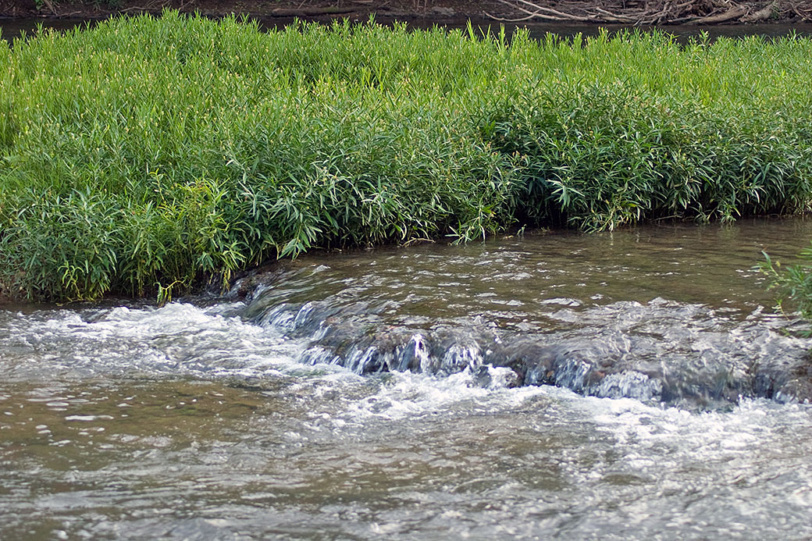Soil testing is an important but often overlooked step when it comes to designing and maintaining a healthy and sustainable landscape. Whether your goal is to maintain a vibrant lawn, plant a vegetable garden, or put in a new flowerbed of ornamentals or natives, the success of your project lies within the soil. By analyzing your site’s growing conditions- sunlight, moisture, prevailing winds, structures and existing vegetation- and combining that with the information gleaned from a soil test report, you can save yourself time, money and frustration.
In an effort to curb the water quality impacts of over-fertilization, JRBP introduced the Lawn Steward soil testing program in partnership with the City of Springfield and through funds received from our Wilsons Creek 319 grant. Through this program, residents living within the Springfield city limits and portions of the Wilsons Creek watershed qualify for a free soil test and three-year nutrient management plan- see map below for details. For those of you living outside of the project area, soil samples can be processed by your local extension office for a small fee.
Collecting your own soil sample is a simple process that requires a few basic tools and knowledge of your current management practices. To get started, review the MU Extension’s guide “Soil Testing for Lawns” and print a copy of the form “Soil Sample Information for Lawns and Gardens” to submit with your sample. To collect your sample, you will need a small shovel, a container such as a plastic bucket, and a plastic bag or a sample box from your local extension office. Collect samples from various locations throughout your lawn or garden at a depth of approximately 4-6”. If you have problem areas or areas with different growing conditions, consider testing these separately. Thoroughly mix your samples together, break up clumps, discard rocks and plant matter, and allow the soil to air dry. Place approximately 2 cups of soil into a plastic bag or sampling box and drop it off with your completed information form at your local extension office.
The sample information form allows you to choose up to three specific plants per soil sample, which can help you determine which plants are most suited for your current growing conditions. For example, let’s say you have a nice sunny spot and you’re interested in planting either pear, apple or peach trees. By specifying all three of these plants on your soil test, you’ll receive recommended soil amendments for all three plant types, which can help factor into your decision-making process.
When it comes to interpreting your test results, the three main things to consider are your soil’s pH, available nutrients and organic matter. This information will help you determine if any soil amendments are necessary to accommodate your desired plants.:
-
Your soil’s pH tells us about the acidity or alkalinity of the soil. If we think back to high school chemistry, we’ll remember that a pH of 7.0 is neutral, lower than 7.0 is acidic, and greater than 7.0 is alkaline. Certain plants such as rhododendrons and blueberries prefer more acidic soils, while other plants like cool-season turf grasses prefer a more neutral pH.
-
Nutrient availability is easily interpreted through a rating system that scores each nutrient on a scale from “very low” all the way up to “excess”. Amendments targeting your soil’s pH and nutrient levels are given in the “Fertilizer & Limestone Recommendations” section of your test report. Be sure to read through the comments section for application information.
-
Soils with high organic matter will have better structure, increasing their nutrient holding capacity and their ability to soak up moisture. When it comes to organic matter, remember to “strive for 5%” or higher.
Before making any soil amendments, calculate the square footage (length x width) of the area to be amended and utilize the application rate specified in your soil test results. Don’t forget to subtract areas such as driveways, sidewalks and other structures from your total square footage. Over application of soil amendments can harm your plants, waste your hard-earned money and have detrimental effects on water quality. You’ve done your homework so that you can take the guesswork out of managing your landscape- don’t flake out now! Not sure how to calculate the application rate for your property or translate that to a bagged fertilizer? Feel free to contact us or your local MU Extension office, we’re here to help!
You don’t need high tech equipment and a degree in soil science to design and maintain a healthy and sustainable landscape. Two cups of soil, a small monetary investment, and a few minutes of your time is all that is needed to make educated decisions that will ensure the success of your planting and protect local water quality.
Brent
Additional Resources:
- JRBP River Ramblings-“Kenny Terrell, Lawn Steward”
- Lawn Steward Soil Testing Program
- MU Extension-Greene County
- MU Extension-“Natural Lawn Care”
- MU Extension-“Soil Testing for Lawns”
- MU Extension-Soil Sample Information Form
- MU Extension-Missouri Master Gardener Core Manual (individual chapters available for download)


